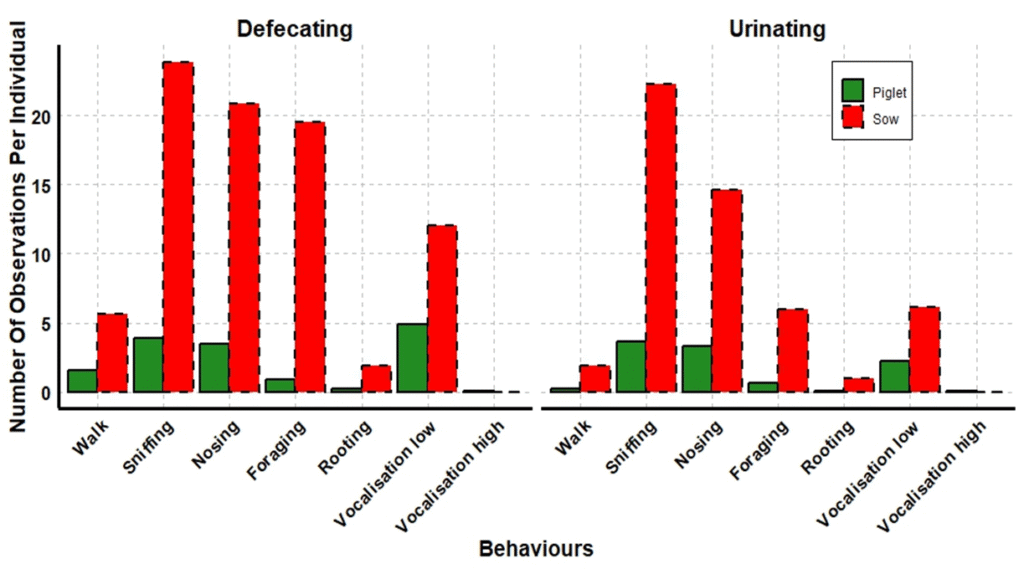I observed a total of 529 elimination events across all animals. This included 214 elimination events for sows, with a distribution of 100 urination events and 114 defecating events. For piglets, 315 elimination events were recorded, with a distribution of 142 urinations and 173 defecation events. The figure here shows the normalised number of observed behaviours of the animals.

The figure here shows the distriubtion of behaviours expressed by the sows prior to elimination. The left graph displays Urination, and the right Defecation.
Sows most frequently expressed sniffing and nosing prior to urination, with lower occurrences of foraging, low-frequency vocalisations, walking, and rooting. Before defecation, behaviours were more evenly distributed, with sniffing, nosing, and foraging being the most common.
Significant differences were found in:
- Walking: more frequent before defecation than urination (χ² = 4.145, p = 0.04)
- Foraging: more frequent before defecation (χ² = 22.285, p < 0.05)
- Sniffing: significantly differed between elimination types, though it remained the most common overall (χ² = 22.989, p < 0.05)
No significant differences were observed for nosing, rooting, or low-frequency vocalisations between urination and defecation.

The figure to the right displays the distribution of behaviours expressed by piglets prior to elimination. The left graph displays Urination, and the right Defecation.
Piglets most frequently expressed sniffing, nosing, and low-frequency vocalisations before both elimination types. Rooting, walking, and foraging were less commonly observed.
Before defecation, vocalisations, nosing, and sniffing were especially prominent.
Statistical differences between elimination types were found for:
- Walking: more frequent before defecation (χ² = 21.746; p < 0.05)
- Low-frequency vocalisations: more common before defecation (χ² = 12.347; p < 0.05)
- Sniffing: significantly more common before defecation (χ² = 10.013; p = 0.001)
- Nosing: differed significantly between elimination types (χ² = 9.2098; p = 0.002)
No significant differences were found for foraging, rooting (p = 0.326), or high-frequency vocalisations (p = 0.309).

The figure to the right displays the distribution of behaviours expressed by piglets and sows prior to urination. The left graph displays piglets, and the right sows.
Both piglets and sows most frequently expressed sniffing and nosing before urination, with no significant differences between them
(Sniffing: χ² = 3.69; p = 0.054, Nosing: χ² = 1.59; p = 0.20).
Piglets vocalised significantly more at low frequencies than sows
(χ² = 13.66; p = 0.0002),
while sows foraged significantly more than piglets
(χ² = 6.63; p = 0.01).
Walking and rooting were expressed less frequently and showed no significant differences between groups
(Walking: χ² = 0.92; p = 0.34, Rooting: p = 0.11).

The figure to the right displays the distribution of behaviours expressed by piglets and sows prior to defecation. The left graph displays piglets, and the right sows.
Sniffing and nosing were frequently observed before defecation in both groups.
Sows sniffed significantly more than piglets (χ² = 4.70; p = 0.03),
while nosing showed no significant difference (χ² = 2.73; p = 0.09).
Piglets vocalised at low frequencies significantly more than sows (χ² = 53.79; p < 0.05),
whereas sows foraged significantly more than piglets (χ² = 86.63; p < 0.05).
Walking showed no significant difference between the groups (χ² = 3.48; p = 0.06),
and rooting was rare in both, with no significant difference (χ² = 1.47; p = 0.20).

To determine if the sows and piglets displayed a spatial preference for performing elimination, I analysed all recorded events as a heatmap.
The figure here shows a heatmap of the spatial distribution and the density of elimination events performed by the sows across the 6 different pens. The highest density of elimination events occurred in the central area of the cropland, spanning across all pens. This indicates a strong preference for this specific area of the cropland. This area is approximately 13 meters away from the huts, which was the sows’ primary resting place.

The figure here shows the density of elimination events performed by the piglets across the six pens. Compared to the sows, the piglets had access to the entire cropland for their choice of elimination.
Similarly to the sows, the piglets showed a high frequency of eliminating within the same central area which spans across all the pens. Another area of interest was the southern end of Pen C, where a high number of eliminations also took place.

The figure here shows the combined heatmaps of the sows and piglets from the previous figures, illustrating certain overlapping areas of elimination. The most prominent overlapping area was within the central region between Pen B and Pen C, but as well on the right-most side of pen D. In contrast, no overlap was found in the northern part of Pen A and B, close to the huts, and nothing in the southern part of Pen C.

So what can I say about these findings?
Find out more on the discussion page!